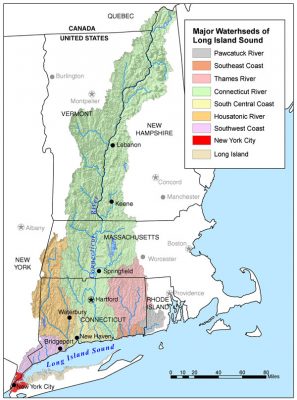About Agricultural Water Security
Soil Health and Conservation
The Long Island Sound Watershed Regional Conservation Partnership Program (LISW-RCPP) focuses on private working lands to manage soil nutrient loss, protect non-industrial forest habitat, biodiversity, and drinking water sources, and reduce erosion to improve resiliency on working lands through riparian restoration. It is a voluntary, cooperative agreement, that enables producers and landowners to install and maintain conservation activities to address priority natural resources and improve water quality.
The Long Island Sound watershed covers more than 16,000 square miles in six states. Within our large region, hundreds of local watershed drain into streams and rivers, which eventually flow into the Sound. Improving the environmental quality of these local watersheds, which often cross municipal and sometime even state boundaries, is a priority in order to prevent pollution from flowing downstream.
The primary resource concern to be addressed by the LISW-RCPP program is hypoxia, or low oxygen levels, caused by excess nutrients, primarily nitrogen, from storm water runoff. Excess nutrients are also impacting drinking water supplies within the watershed. The aim of this component of the program is to reduce nitrogen loading to Long Island Sound from working lands, and improve overall soil health, biodiversity, and source water protection on farms by increasing the adoption of NRCS conservation practices.
Through the Soil Health and Nutrient Management program area, Conservation Districts will provide technical assistance to navigate the Environmental Quality Incentives Program (EQIP ) eligible agricultural producers, especially those not previously reached by USDA NRCS programs. This will include the development of conservation plans leading to the completion of nutrient management plans on farms throughout the watershed over the life of the program.
In collaboration with Conservation District, work can include soil, plant and manure sampling and testing as needed, as well as monitoring and documentation of conservation practices implemented as a result of conservation planning activities. In collaboration with technical assistance provided by the University of Connecticut Cooperative Extension Services, this conservation planning will lead to implementation management strategies that promote nutrient cycling and retention.
Are you the owner or manager of an agricultural operation?
Do you think a conservation plan can benefit your operation?
Contact us at extension@uconn.edu.
Water Quality
Our water quality project aims to achieve long-term agricultural water security for existing and new agricultural producers in the state of Connecticut.
Our goals are to:
- Develop baseline conditions for statewide water use
- Improve irrigation efficiency and enhance water storage capacity
- Develop drought preparedness plans for producers
- Provide technical assistance to increase economic resilience to drought
Visit the UConn CLEAR Changing Landscape Connecticut and Long Island Sound Land Cover and Change website for detailed watershed information. Changing Landscape is a remote sensing-based land cover study that charts landscape changes in Connecticut and portions of New York. It covers the 30-year period from 1985 to 2015 (with in-between dates of 1990, 1995, 2002, 2006 and 2010). It includes information on basic land cover, as well as subsidiary analyses of riparian corridor land cover, impervious cover and forest fragmentation analysis.
Project Area
